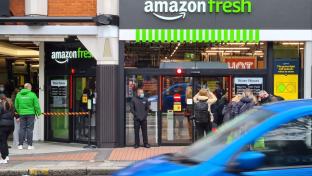4 Ways to Increase Sustainability in Your Supply Chain
Sustainability leaders across the consumer and retail landscape are sensing the push from customers, investors, and other constituents to respond to growing ESG expectations. But for many, identifying and mitigating the impact of their emissions is just the starting point.
Research from the UN Global Compact indicates that scope 1 and 2 emissions — direct emissions from owned or controlled sources and indirect emissions from the generation of purchased energy — may represent less than one-third of your organization's total emissions portfolio. Scope 3 emissions, consisting of all indirect emissions from upstream and downstream suppliers, usually account for more than 70% of a business's carbon footprint.
You may already have considered Scope 1 and 2 emissions, but to meet the growing demands of consumers and impending disclosure standards, you’ll need to examine how your end-to-end supply chain advances (or hinders) your ESG strategy.
Read on for 4 ways to boost sustainability in your supply chain and how to integrate your supply chain into your overarching ESG strategy.
Consider the Cradle-to-Grave Impacts of Your Supply Chain
The impact of your supply chain on greenhouse gas emissions and the local communities it touches is undoubtedly vast in scope. Accordingly, when evaluating its impact, you must examine it holistically, from end to end. Here are a few ways to evaluate the impact your supply chain has on human and environmental ecosystems across every stage of the product lifecycle:
Resource Extraction: Sourcing raw materials that can be recycled, have longer lifespans, and whose extraction processes are less carbon-intensive will create opportunities for carbon footprint reduction. Consider sourcing materials locally when possible and stay committed to holistic stewardship of the environments and communities they come from.
Manufacturing: Manufacturing is often the most significant contributor to your emissions footprint. Consider your products’ end-of-life destination as you devise the manufacturing methods used to create them. How could you reduce manufacturing impact by using longer-lasting materials, revised construction methods, or incorporating more recycled and recyclable materials?
For instance, implementing a production and consumption model allows manufacturers to bring materials back into the economy without discarding them. One example is biofuel production from waste products. McDonald's in France has collected food waste from its restaurants to generate biofuel.
Transportation and Shipping: Consider leveraging recyclable packaging materials for shipping. Alternative packaging strategies may reduce product size and weight, thereby reducing emissions from transporting your goods to consumers. Ikea has pioneered the art of shipping products in flat-packs for consumers' at-home assembly.
Product Use: Create a circular business model for product use. Most involve a combination of three basic strategies:
- Retaining product ownership: The producer rents or leases its product to the customer rather than selling it. Thus, the producer is responsible for products when consumers have finished with them.
- Extending product life: The product use is extended for longer periods. Durability is a critical competitive differentiator and provides a strong rationale for premium pricing.
- Designing for recycling: The product's primary material is used and then reused for a different purpose.
Disposal: Use as many recyclable materials as possible. When the reuse or recycling of materials or products isn’t possible, it’s essential to recover energy directly from the manufacturing process or by incinerating the products.
Calculate Your Supply Chain Emissions Inventory
While supply chain emissions represent the most significant subset (70%) of most companies' emissions portfolios, there’s no one-size-fits-all strategy to tackle them across industries and organizations. Your company's size, product, service offerings, and other business activities will bring unique challenges and growth opportunities.
Understanding your supply chain's emissions impacts begins with creating a detailed inventory and benchmarking your performance against industry peers. From there, leverage the knowledge of your emissions hotspots to identify solutions — many of which may already exist in the market.
Create an Inventory: Start this journey by creating an emissions inventory to gain visibility across your value chain. Eliminate information silos by providing all critical data owners a seat at the table. Interventions for greater efficiencies will be a natural outcome of this process.
Reference the GHG Protocol: The Greenhouse Gas Protocol Corporate Standard classifies GHG emissions into three "scopes." Work to identify your emission hotspots within each scope; as discussed, most companies find that scope 3 emissions comprise most of their overall impact profile.
Benchmark Your Performance: Understand how your performance compares to your peers by researching their emissions impact across all three scopes (often disclosed in a public-facing CSR or ESG report). This will help identify your greatest opportunities for improvement.
Understand Solutions: Choose a hotspot that would be most impactful to address from an emissions perspective and identify solutions already being leveraged in the marketplace. Whether it's creating new packaging or sourcing more local materials, there are many opportunities to consider.
Consider the Impact of Your Supply Chain on People and Communities
Once you understand your supply chain's emissions impacts, it's essential to consider its broader impact on people and communities. Understanding this will require navigating the potential ethical, legal, and economic implications of sourcing decisions through careful strategic planning.
Retailers that select suppliers who provide unsafe working conditions, employ child or forced labor, or participate in inhumane animal testing practices expose their business to unnecessary risk. Just as the negative impacts of poor supply chain planning can be significant, so can the benefits of engaging the right suppliers and partners across your value chain that align with your broader ESG and DEI+J strategies.
Consider Your Impact: When engaging in sourcing activities, it's important to be mindful of their impact on local communities, particularly those that are more vulnerable. Even small economic or environmental disruptions can have catastrophic consequences on these populations. For instance, the degradation of natural resources or local water supplies can lead to food insecurity and economic hardship for communities in the area.
However, businesses can take steps to positively impact these communities by reworking their supply chain and sourcing activities. This could involve partnering with supplier communities on initiatives to restore water sources and improve access to clean water, reforestation efforts, or other strategies to promote economic growth and independence for local suppliers.
Understand Your Responsibility: Your ESG strategy is more than a bottom-line endeavor; while share prices are at stake, so are the communities your value chain touches. Investors, employees, customers, and other stakeholders are pushing for increased social impact awareness. Consider your supply chain strategy as another avenue for pursuing ESG and DEI+J strategic advancements. Ensuring occupational health, ethical labor practices, and sustainable production up and down your value chain is about more than resource planning. It’s about identifying and addressing fundamental human rights concerns.
Choose Values-Aligned Suppliers: As you look for opportunities to pursue ESG and DEI+J priorities in tandem with other business needs, consider strategic partnerships with suppliers aligned with your values. Work with them to incorporate similar goals into their own supply chain operations and practices.
Think Through How to Integrate Your Supply Chain into your ESG Strategy
As you understand your organization's impact and work toward reimagining your supply chain's future state, consider what leaders, incentives, retail consulting expertise, and other investments you’ll need to fully integrate your supply chain with your ESG and DEI+J strategies. Here are a few tips to help you get started:
Employ Design Thinking Principles: Design thinking principles promote user-centricity at every stage of the ideation process. With empathy, consider all stakeholders engaged across your value chain and the impacts on resources, people, environments, and communities. As you prototype solutions, be sure to challenge your current assumptions and consider all voices. From there, experiment and iterate until you've achieved your desired goals.
Create a Supplier Scorecard: Benchmark suppliers' performance across ESG and DEI+J metrics by creating and implementing a supplier scorecard. Relevant metrics may include a biodiversity action plan, waste reduction measures, workplace health and safety measures, equal employment opportunities, or a long-term plan for emissions reduction.
Leverage the Carrot and Stick Approach: Create a governance model that includes both robust supplier incentives and an accountability framework. Incentives (carrots) could include premium payments — suppliers that score above a certain threshold are paid a premium on purchased products. Accountability (sticks) could include, for example, making it mandatory for suppliers to demonstrate their commitment by setting science-based targets.
Model Scenarios and Measure ROI: Run reduction modeling scenarios to anticipate what tactics will make the most difference for your overall emissions. This approach will look different based on your company's industry segment, retail product(s), etc. An example for C&R organizations could be pursuing 'Energy Star' certifications for your products. As ideas are implemented, measure their ROI to benchmark their overall effectiveness.
So, What's Next?
As you consider integrating your supply chain into your broader ESG strategy, remember that all change starts somewhere small and builds as teams grow toward alignment. Follow the 80-20 rule — the minority of your suppliers will make up most of your emissions, so concentrate your efforts there in the early stages of implementation.
—John Chalhoub and Dale Roth, Point B





